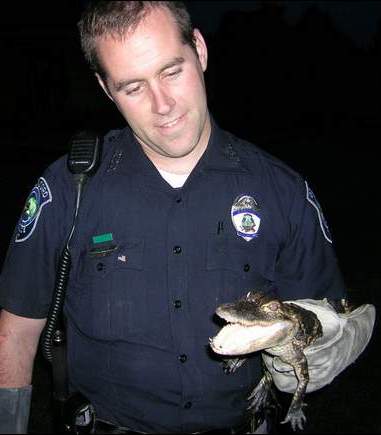More Gators
Posted by: Loren Coleman on September 6th, 2006
Officer Kyle Finney, 27, carefully holds the 2-foot-long alligator he pulled from Horseshoe Pond, near Concord, New Hampshire, on August 29, 2006.

Concord Police Department photograph.
The local newspaper Concord Monitor noted that Kinney was already known as a hero for pulling an 84-year-old woman from a burning automobile last year. Now he can add alligator recovery to his resume.
When the paper reported on the sightings of the gator the day before, the Concord Monitor mentioned that a 3-feet-long alligator had been picked up from Bath, New Hampshire, a few weeks earlier.
About Loren Coleman
Loren Coleman is one of the world’s leading cryptozoologists, some say “the” leading living cryptozoologist. Certainly, he is acknowledged as the current living American researcher and writer who has most popularized cryptozoology in the late 20th and early 21st centuries.
Starting his fieldwork and investigations in 1960, after traveling and trekking extensively in pursuit of cryptozoological mysteries, Coleman began writing to share his experiences in 1969. An honorary member of Ivan T. Sanderson’s Society for the Investigation of the Unexplained in the 1970s, Coleman has been bestowed with similar honorary memberships of the North Idaho College Cryptozoology Club in 1983, and in subsequent years, that of the British Columbia Scientific Cryptozoology Club, CryptoSafari International, and other international organizations. He was also a Life Member and Benefactor of the International Society of Cryptozoology (now-defunct).
Loren Coleman’s daily blog, as a member of the Cryptomundo Team, served as an ongoing avenue of communication for the ever-growing body of cryptozoo news from 2005 through 2013. He returned as an infrequent contributor beginning Halloween week of 2015.
Coleman is the founder in 2003, and current director of the International Cryptozoology Museum in Portland, Maine.










Wonder what they did with the little fellow?
That little guy is adorable.
Looks a bit bigger than 2 ft though.
Being from southern Louisiana, I have had and seen many baby gators.
I’d say probably around 3 ft or better judging by the head.
There is a little known, but accurate fact, about American gators. The distance between the eyes in inches is equal to the length in feet. I have seen this used as a way to measure gators many times. The way it is done is between the eyes at the top of the socket/ridge on the skull. I did not believe this at first myself until hanging out with a state gator trapper for a while.
Bet the 84 year old woman’s teeth weren’t as sharp. I didn’t think gators could winter that far north, can they?
As long as the waters are warm enough and the food is plentiful, gators are able to survive anywhere they want. The only other thing they would have to watch for is anything crazy enough to try for gator soup.
It was most definitely a released pet –
We had one about the same size in a local lake in Nebraska.
Don’t buy gators as pets!
i saw a documentary a couple of weeks ago on crocodiles surviving in the african desert. while seasonal rainfalls fill up a lake for them to live, hunt, mate they survive the rest of the year (when the lake is completely dry and dead-dry) deep in the ground. they dig caves almost 10 to 15 meters deep where they spend the dry season in some kind of hibernation.
Reptiles are amazing (and resilient) creatures.
I would be more likely to jump right on the released pets bandwagon if these were caiman showing up in ponds, as these are what I have seen sold as “alligators” in pet stores in the past, but it is illegal to own or sell American alligators as far as I know.
That means that if these are released pets, which I concede is most likely the case, whoever released them should be in REAL trouble for not only releasing a non-regional exotic, but for illegally transporting live wildlife over state lines.
I know that, most likely, this is what has happened, and probably why they end up in ponds and lakes while a legally bought caiman can be turned around and sold to someone to make boots or donated to a zoo, wildlife refuge, etc.
But, as I noted, reptiles are amazingly resilient. It wouldn’t surprise me to find out that a few released gators were able to last through more than one northern winter. I’m not saying there is any possibility of breeding populations in any various New England waters, just that I wouldn’t be surprised if gators bigger than 2 to 3 feet ever show up outside of their native climes.